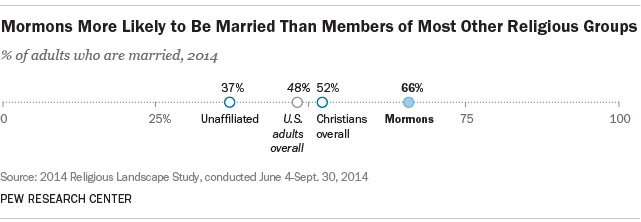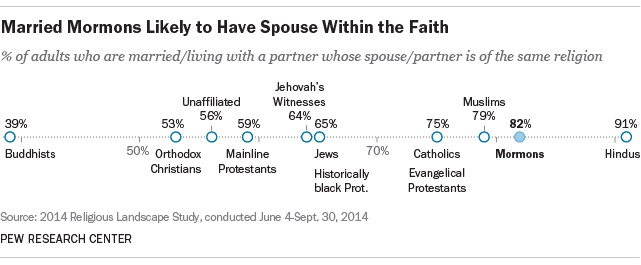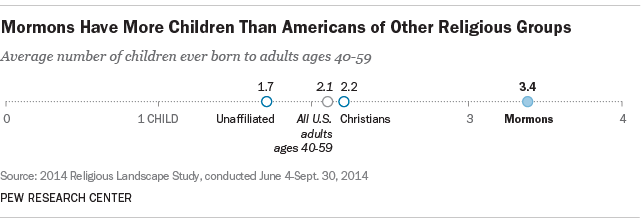
The share of Americans who identify as Mormons has roughly held steady even as the percentage of Christians in the U.S. has declined dramatically in recent years, according to the Pew Research Center’s 2014 Religious Landscape Study. And the study found Mormons stand out in other ways: They have higher fertility rates and are far more likely than members of most other major religious traditions to be married – especially to other Mormons.
Mormons made up 1.6% of the American adult population in 2014, little changed from 2007 (1.7%), the last time a similar survey was conducted. By contrast, the percentage of Christians in the U.S. has dropped from 78.4% to 70.6% during the same time period.
Two-thirds (66%) of U.S. Mormon adults are currently married, down slightly from 71% in 2007 – but still high compared with current rates among Christians overall (52%) and U.S. adults overall (48%). (Marriage rates are lower across the board than they were several years ago.)

Compared with many other religious groups, Mormons who are married are especially likely to have spouses who share their faith. Eight-in-ten Mormons who are married or living with a partner (82%) have a Mormon spouse or partner; among religious traditions, only Hindus have a higher rate of “in-marriage” (91%).
Mormons also tend to have more children than other groups. Mormons ages 40-59 have had an average of 3.4 children in their lifetime, well above the comparable figure for all Americans in that age range (2.1) and higher than any other religious group. Overall, Mormon adults have an average of 1.1 children currently living at home, nearly double the national average (0.6).

These findings line up with U.S. Mormons’ priorities as expressed in a 2011 Pew Research survey of the group. In that survey, 73% of U.S. Mormons said that having a successful marriage is “one of the most important things in life,” and 81% said the same about being a good parent. Among the general public, half or fewer call each of these life goals “one of the most important things in life.”
Some other findings about U.S. Mormons from the 2014 study include:
- Most adults who were raised as Mormons still identify as Mormons today (64%), a retention rate roughly on par with that of evangelical Protestants (65%) and slightly above that of Catholics (59%). Among those who were raised as Mormons but have left the church, most are now religiously unaffiliated (21% of all those who were raised Mormon).
- About as many people have joined the Mormon faith after being raised in another religious tradition (0.5% of U.S. adults) as have left the church after being raised Mormon (0.6%).
- While the U.S. population has become more racially and ethnically diverse in recent years, the racial and ethnic composition of Mormons has not changed much; Mormons remain overwhelmingly white. Mormons were 14% non-white in 2007 and 15% non-white in 2014; Christians overall were 29% non-white in 2007 and 34% non-white in 2014.
- Utah still has by far the biggest share of Mormon residents of any state (55%), a percentage that has changed little in recent years.
